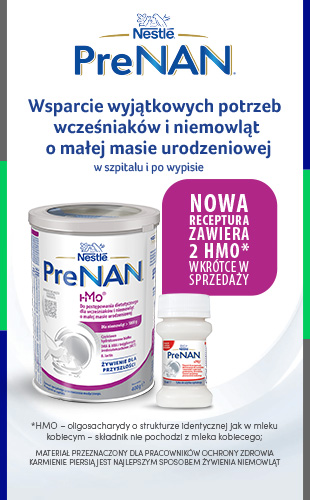Plamy typu café au lait u dzieci i młodzieży
Słowa kluczowe / Keywords:
Streszczenie:
Plamy typu „kawa z mlekiem” (fr. café au lait, CAL) są często spotykanymi zmianami skórnymi o charakterze wrodzonym lub nabytym. Podczas gdy pojedynczą plamę typu CAL na skórze spotka się u ok. 25% osób w wieku > 1. miesiąca życia, to prawdopodobieństwo wystąpienia 3 lub więcej plam tego typu znacznie maleje w populacji (1,1-3,3%) i stanowi wskazanie do skonsultowania pacjenta w poradni referencyjnej w celu rozpoczęcia diagnostyki w kierunku chorób nerwowo-skórnych (dawniej: fakomatoz). Najczęstszą neurodermatozą jest nerwiakowłókniakowatość typu 1 (ang. neurofibromatosis type 1, NF1; dawniej: choroba Recklinghausena), natomiast znacznie rzadziej występują: NF typu 2, zespół Legiusa, zespół McCune’a-Albrighta, zespół LEOPARD i inne sporadyczne zespoły. Istotną kwestią jest zróżnicowanie plamy typu CAL z innymi hipermelanozami. W artykule dokonano charakterystyki występowania plam typu CAL na skórze, ze szczególnym uwzględnieniem częstości tego objawu, patogenezy chorób z nim związanych oraz zasad postępowania z pacjentem, u którego występują tego typu zmiany.
Abstract:
Café au lait macules (CALMs) are common congenital or acquired pigmented skin lesions. The prevalence of one CALM was noted in 25% of children
older than 1 month of age. Three or more CALMs were reported to occur in 1,1-3,3% of general population. This symptom should be regarded as an indication to refer the patient to the Neurocutaneous Syndromes Center. Neurocutaneous disorders are congenital disorders manifesting with central nervous system and cutaneous abnormalities. Currently more than 30 entities belong to this group, with neurofibromatosis type 1 (NF1) being the most frequent disease. Less frequent neurocutaneous diseases are: NF type 2, Legius syndrome, McCune’a-Albright syndrome, LEOPARD syndrome and other rare diseases. Due to the variety of syndromes, CALMs may be difficult to distinguish from other pigmentary lesions. The aim of this paper is the evaluation of the frequency of CALMs occurrence with the analysis of pathogenesis of diseases associated with this skin lesions. We also present the strategy of management with the patient presenting CALMs.
Strona przeznaczona dla lekarzy i osób pracujących w ochronie zdrowia. Wchodząc tu, potwierdzasz, że jesteś osobą uprawnioną do przeglądania zawartych na tej stronie treści.


